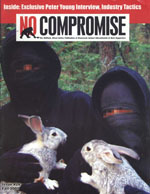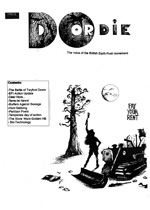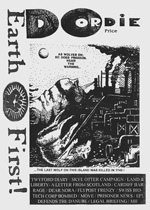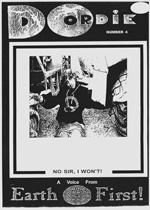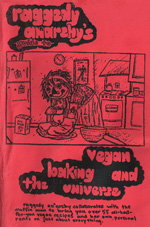» Next Entries
The Archives
-
No Compromise, Periodicals
No Compromise #27-28
03.18.13 | PermalinkNo Compromise #27-28 (2005. Santa Cruz / San Francisco, CA)
The volunteer staff of No Compromise may have only published two issues in 2005, but both were valuable sources of news and ideas from across the globe. As always, the reports inside are bitter sweet. Many animals were rescued, many abusers felt some heat, and many people rose up and fought back. Then, there was the backlash, the senate hearings, and the arrests. The movement has never stopped though, and No Comp always served as a reminder that come hell or high water we were all going to forge ahead, sometimes stronger, sometimes weaker.
One unfortunate development in 2005 was the arrest and conviction of Chris “Dirt” McIntosh. Despite receiving movement support, Chris turned to Nazi groups in prison for advice and friendship. Soon, he counted himself among their ranks, and requested to be removed from animal lib prisoner lists. He would have been removed anyway though: there is never room in our struggle for a Nazi!
Luckily, other prisoners continued to show courage, dignity, and resolve from behind bars. Both 2005 issues of NC contain inspiring letters and interviews with jailed comrades. All in all, this is another must read year for the best animal liberation publication to come out of the United States.
…
-
No Compromise, Periodicals
No Compromise #23-26
02.17.13 | PermalinkNo Compromise 23-26 (2004, Santa Cruz / San Francisco, CA)
One of the lessons that archiving old animal liberation publications has taught me is that the most extreme actions have rarely produced much in the way of results for animals. A public that already sees veganism as odd might still see the value of rescuing animals from a laboratory, but will never support a car bombing. When innocents are injured, or when murder was the goal, the backlash starts to creep into our own ranks, and as we fracture law enforcement and industry groups take advantage. In the end, I can think of no bombing (or contamination, or grave robbing, etc.) which advanced the cause of animal rights more than it harmed it. This is not to say that bombings and the like could never be successful. At later stages of many revolutionary struggles, when the majority of the public supports the cause, bombs can clear away in one night what years of protest could not. While a movement is in its infancy, however, it could be argued that more often than not bombs blow up in our faces.
And so it was in 2004 when a group calling itself the Revolutionary Cells Animal Liberation Brigade carried out two bombings of HLS related targets in California. The movement was left to make lemonade from truly shitty lemons, and No Compromise did their best to mitigate the harm of the actions while keeping activists focused on the real enemy.
The year continued with the indictment of the SHAC 7, the emergence of Austria as a leader in the movement, and some exciting open rescues. Sarahjane Blum and Ryan Shapiro’s organization, GourmetCruelty.com, carried out one such operation that piqued public interest and eventually resulted in a sympathetic program on Animal Planet. Elsewhere Gina Lynn was imprisoned for defying the Seattle grand jury, Billy Cottrell was arrested for a massive SUV dealership arson, and the Universtiy of Iowa was treated to the most sophisticated lab raid to occur since the early 90s.
Every time we post a year of No Compromise we say the same thing: that this is essential reading for those who wish to understand the recent history of our movement. This posting is no exception. No Compromise was the best AR publication of its era, and 2004 saw the publication refining its strengths and providing their readers with four of the best issues yet.
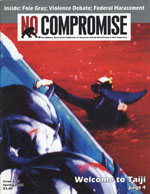



-
No Compromise, Periodicals
No Compromise #20-22
11.15.12 | PermalinkNo Compromise #20-22 (2003. Santa Cruz / San Francisco, CA)
No Comp scored another great year in 2003, this time by going deeper into practical instructions for campaigning, and also by examining the smaller stories in greater detail. While the high profile victories of anti-HLS activists were given their due, inspirational figures who had passed on were also given touching coverage. Issue #20 features articles on early Band of Mercy and Animal Liberation Front founder Sue Smith, and Sweden’s animal lib die-hard, Ake Soderlund. Similar examinations of our past, and the courageous figures whose shoulders we stand upon, pepper the 2003 issues. Of particular note is the article on Henry Hutto in issue #21.
2003 was also the year that Rod Coronado finally got off of probation and was allowed to participate in the movement again. His writings for No Compromise were as subversive and inspiring as ever, and it is easy to see why the government considered him such a threat.
As the year progressed No Comp moved to a magazine format and tightened their graphic design skills in response to Jake Conroy’s work on the SHAC USA newsletter. These glossy issues were excellent contributions to the movement, and it is a shame that in only a few more years NC would cease to exist altogether. These information (and inspiration!) packed issues are worth reading again to inform and encourage our current actions.


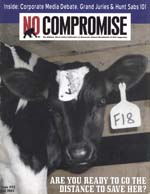
-
Periodicals
Animal Info
10.18.12 | PermalinkAnimal Info #1-8 (1995-1996. Christchurch, New Zealand)
Animal Info was a thin, photocopied newsletter that was published with the hopes of increasing the militancy of New Zealand’s animal activists. It’s pages contained news relevant to local campaigns, alongside the home addresses and phone numbers of various animal abusers. The zine’s rhetoric was, at times, over the top and even once racially insensitive. Issue #1 contains an N-bomb on the front page that was seemingly intended to make an anti-racist / speciesist point, but instead has the exact opposite effect.
Still, Animal Info is an inspiring example of committed activists organizing on a grassroots level and agitating for greater commitment in the struggle against speciesism. It’s international news coverage was impressive given the magazines small number of pages, and nicely bridges the U.S. coverage lapse between the time Open the Cages stopped publication and No Compromise began. All of us at CG would love to see this type of paper return to regional organizing in the United States and abroad.
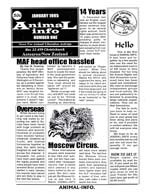
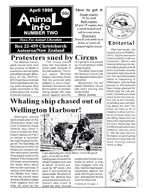
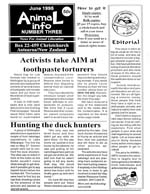


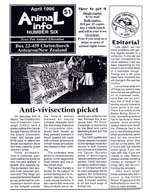
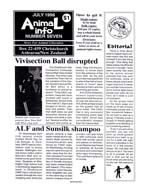
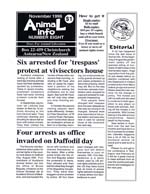
-
Do or Die, Periodicals
Do or Die #8
10.03.12 | PermalinkDo or Die #8 (1999, Brighton, England.)
There is nothing to say about Do or Die that has not already been said on this website- it was the best environmental journal in history and this issue is full of the same critical theory, inspiring coverage, and beautiful graphics as every other issue. What makes this volume unique though is the in depth coverage of J18, the so-called “Carnival Against Capital” that rocked the world in 1999 before being quickly forgotten. Also of interest is the recurring “Animal Antics” feature, and hundreds of pages of indigenous resistance, radical history, eco-feminism, and direct action coverage. As we have said before, Do or Die is a must read, and this issue is no exception.

-
Do or Die, Periodicals
Do Or Die #1,3,4
06.18.12 | PermalinkDo Or Die #1,3,4. (1993-1994, Brighton, England.)
When a group of five environmentalists gave birth to Earth First! in 1979 they could have hardly imagined how far the movement would spread and how influential its politics would become. From humble roots in the Southwest, chapters began proliferating across the United States and soon left its borders as the worldwide eco-catastrophe inspired people everywhere to take action. In 1992 the first British Earth First! chapter was founded, and within a year one of the most exciting periods of mass direct action in modern history was well underway.
From the start the movement in the UK seemed a little smarter than their US counterparts, perhaps because they had learned from the worst offenses of the fledgling stateside groups. Eschewing the more anti-social elements of American deep ecologists, our comrades across the pond sought to build a broader base and included those working in other movements. They also seemed to have a creative flare for mischief, and their best actions not only stopped the despoilers- they also put a smile on the face of rebels everywhere.
The spectacular campaigns of the UK EF!ers were covered in Do or Die!, a wonderfully self-critical journal that started as a small newsletter and blossomed into a massive annual tome by the end of its existence. Find the other issues HERE.
…
-
Most Popular, Periodicals, The Beast
The Beast #1-#10
03.29.12 | PermalinkThe Beast #1-#10 (1979-1981. London, England.)
On the 5th of November of 1947 a baby lowland gorilla, stolen from his home and family in West Africa, arrived at the London Zoo. As it was Guy Fawkes day, this newest prisoner was named in his honor. Guy the Gorilla went on to become one of the biggest money makers for his captors, and thousands of visitors would gawk at him, occasionally throwing him sweets to eat. Eventually the candies rotted his teeth, and during a surgery to repair them, he had a heart attack. The budding animal liberation movement in the UK took notice, and a group of people began producing buttons with Guy’s face on them. As the buttons grew in popularity, this small group decided to make a newspaper, and soon The Beast became an insert in International Times. After two such inserts the editors struck out on their own, and soon this beautiful publication was on newsstand racks in England and abroad. It was produced for two short years, and remains one of the best animal liberation (and anti-nuke!) publications of all time.
The Beast began it’s run during a time of global social and political decay. As the voters of the west fell under the spell of charismatic and brutal conservatives, a broad coalition of anti-nuke, anti-fascist, union, conservationist, environmentalist, and animal lib activists entrenched themselves to fight back. As things “hotted up” in the streets, the staff of the magazine followed the action and ideas of an astonishing number of people and groups. The tone in the early issues is optimistic, brave, and intelligent, and offers a fascinating glimpse into the psyche of activists during the era.
The history covered is equally incredible. Articles offer the story of the first animal liberation raid in the United States, the origins of the Hunt Saboteurs Association, and the early days of the Animal Liberation Front. Lost figures, like OG U.S. Hunt Sab and eco-prisoner John Walker, come back to life in these old pages. Important thinkers, such as Henry Spira, Peter Singer, Richard Adams, and Paul Watson were regular contributors. Then, there are the images! Between the full color, glossy covers are amazing pictures of early raids, movement legends, and epic moments on our movement’s timeline. One such photograph, taken in 1980 and shown in issue #10, captures a small group of Animal Liberation League activists standing with banners in a field, bandannas covering their faces, fists in the air. More than 30 years later young people still show that same spark of rebellion and hope, and with our archiving of this magazine, perhaps they will now better understand the revolutionaries who came before them.
When we started Conflict Gypsy one of our dreams was to obtain a complete set of The Beast. After just one year of existence, we have met this goal. As our birthday gift to you we offer the Complete Newsstand Collection of The Beast, perhaps our most important single posting so far…










-
Most Popular, One-off publications
Raggedy Anarchy’s Guide to Vegan Baking and the Universe
02.23.12 | PermalinkRaggedy Anarchy’s Guide to Vegan Baking and the Universe (1989? Carmichael, CA)
Consumer culture is rampant in its appropriation and assimilation of radical ideas, taking things that were once revolutionary (including the word “revolutionary” itself!) and turning them into products to be purchased or new forms of advertising. DIY Skater culture became a vehicle for hocking Mountain Dew, Tylenol, and Nike shoes, hardcore music influenced the crappy, commercial “now I’m singing, now I’m yelling” garbage heard on the radio today, and in a world where sorority girls have knuckle tattoos and think Discharge is a clothing brand, can punk still be a threat? These subcultures may have never truly threatened the system, but at one time they provided a safe space from it, and in that space some truly liberatory ideas flourished.
If you have grown up in a world where vegan cookies are sold at supermarkets and every animal free product imaginable can be bought on the internet, veganism might just seem to be one more compartment in the consumerist toolbox. But there was a time when this wasn’t so. In the early days of veganism you had to be seditious to even consider such a thing. It was unheard of, and given cultural resistance to the changing of food choices, it was also rebellious. While many health oriented and religious groups had advocated an animal free diet, animal rights oriented veganism was uncharted territory. (And at times unwelcome in the animal rights community! Many New Zealand anti-vivisection societies ran newsletter articles in the late 70’s and early 80’s warning of possible “infiltration” efforts by vegans!) On it’s path to mainstream acceptance, the first pioneering steps were taken very often by punks, hardcore kids, and others existing on the fringes.
Because being a vegan was such a new concept at the time, people simply did not know how to do it. Recipes and helpful hints began spreading through album liner notes, self published cook-zines, and the network of all ages venues that began springing up in the late 1970s. Making veganism accessible to the young and poor brought animal rights into communities that were already resistant to cultural norms, and soon animal liberation joined the roster of causes tattooed on the hearts of misfits everywhere. Diets were changed, but more importantly, action was taken. For proof we present Raggedy Anarchy, an amazing cook-zine that was hugely influential on the likes of Isa Moskowitz and others, written by a young punk and hunt saboteur from California.
Raggedy Anarchy will help you make delicious cakes, but it will also spark your desire to subvert the omnicidal paradigm! Sometimes funny, sometimes introspective, and always inspiring, we post this classic in the hopes of making Snacktivism a threat again and convincing our readers to “bake for themselves what tomorrow never brings!”
…
-
Arkangel, Periodicals
Arkangel #4,5,7
01.02.12 | PermalinkArkangel #4,5,7 (1990-1991. London, England)
Our posting of the complete Arkangel continues into the 90s with issues 4, 5, and 7. The omission of issue 6 is not an oversight- it was never printed. Arkangel was founded by Ronnie Lee, who was serving a 10 year sentence during the magazines early years, and edited by Vivien Smith, who found herself in a jail cell by the time issue #6 was scheduled for release. Sensing the possibility of shutting down this crucial publication, law enforcement in England ransacked the Arkangel office just before the layout of issue #6. It was lost to the ages, and with Vivien facing serious charges a new team of interim editors anonymously produced Arkangel #7, causing a slight decline in the publication’s overall quality.
The history covered by these three issues is tremendous. The death of Mike Hill, Animal Aid’s disastrous labeling of direct action as “terrorism,” and the return of the ALF Press Office are all reported upon, along with updates from groups around the world. Amidst the columns reporting on the actual work of activists though is a disturbing amount of debate, much of it centered on whether animal rights groups should allow participation by racists, nationalists, and separatists. The back and forth articles from one issue to the next mostly fail to recognize the most offensive nature of the argument – that there should even be an argument! It boggles the mind that anyone could see a benefit to taking on the baggage of these far right lunatics and their disgusting politics. During a decade where skinhead violence claimed the lives and dignity of so many it is particularly disheartening that some in our movement saw fit to offer these thugs a place at our table.

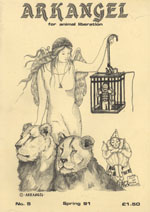

-
Periodicals
South East Liberator
08.15.11 | PermalinkSouth East Liberator (1992 – 1996. West Sussex, England)
Editors note: When we originally posted South East Liberator in 2011 we had an agreement with its primary author to keep her identity a secret until after her death. We are sad to report that Gillian Peachey, a long time animal liberationist and former ALF prisoner, has passed away this week. Now that she is no longer with us we can reveal that she was the anonymous figure behind this publication. Rest in peace, Gilly.
One of the most important things we do at TALON is to preserve the telling of our movement’s story by it’s participants. In the case of South East Liberator, we are almost preserving the story of our movement as told by the mainstream media and then copied and pasted by it’s participants. Confused? Well, South East Liberator was largely written and edited by one person who would include press clippings for major actions around the area she was active in- actions for which she was often responsible! She later ended up doing time for planting incendiary devices, which put this popular DIY publication out of business.
South East Liberator was angry, over-the-top, and compiled by front-line activists giving their all for animal liberation. We are very proud to have the complete collection hosted on our site, along with this new introduction by the editor:
“The Liberator was produced in the ‘90’s by a small group of determined animal rights activists to publicize how much could be achieved by working quietly within a close knit group, and to encourage like minded people to carry out similar actions.
Economic sabotage will always be one of the most effective ways of hitting the abusers where it hurts them most and we, along with other similar groups throughout the country, were proving this time and again.
Liberations, bombings, arson attacks, massive damage to property and vehicles and general sabotage were carried out week after week, with the cops going round in circles!
Thousands of lives were eventually saved through liberations and hellholes closing. Many many hundred of thousands of pounds worth of damage was caused along the way.
Inevitably there were arrests and imprisonment but nobody who was totally involved then, for the right reasons, would say that they had any regrets for any of their actions. Many of us are still involved in the fight for animal liberation and always will be.
Personally the only regret I have is that I’ve never done enough to save enough lives. Oh, and getting caught of course!!”
-Anon








…
» Next Entries

